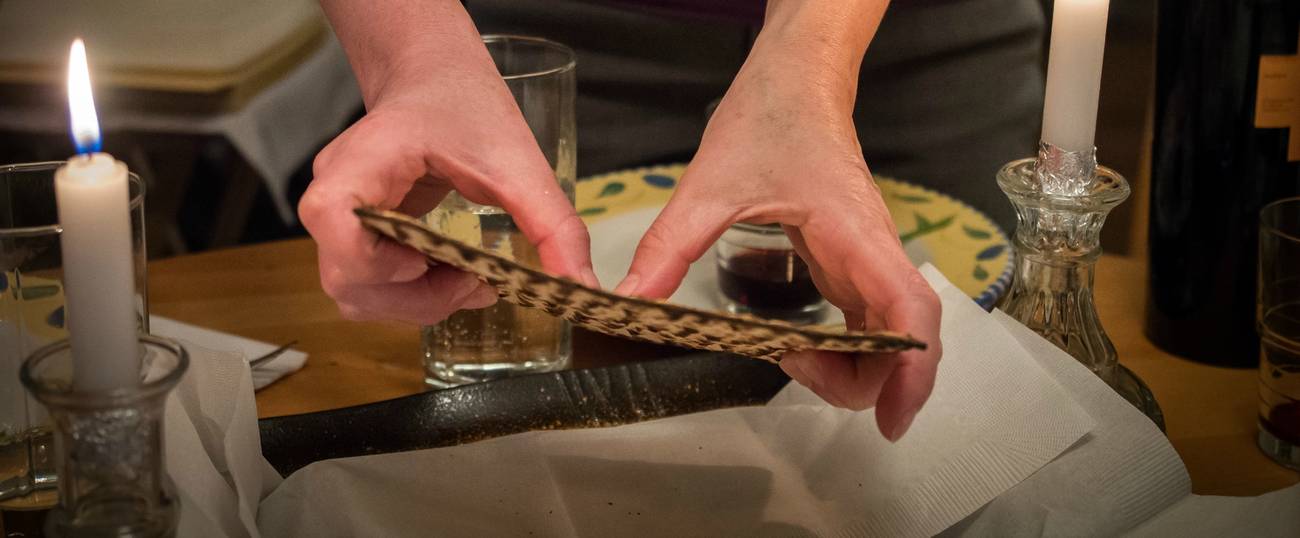With an Outstretched Arm
How my mother uses costumes at the Passover Seder to keep our family whole




My mother started leading the family Seder after my father died, when I was 6 and my brother was not yet a toddler. She would sit at the head of the table and use his copy of the Haggadah, marked with his handwritten notes about how to order the readings. As our Haggadot have fallen apart over time from wear, we have replaced them, but never that one.
After about a decade of leading Seders, my mom decided to enhance the routine by adding a theme to the holiday meal. Every year, she expects each of her dozen or so guests to come prepared with relevant thoughts or readings that are in some way connected to that year’s theme; costumes are mandatory.
My mother’s Seder themes have ranged from the concrete to the metaphysical, and the costumes follow suit—from simple to elaborate to full-on set designs. They are always memorable. For example, the first year’s theme was “First Passover in the Desert,” for which my brother and I twisted sheets into robes for ourselves and transformed the living room into a makeshift Israelite tent under which we ate roasted lamb on the floor (instead of chicken soup at the table). Another theme in this canon was “Come Dressed as a Jew from History You’d Like to Meet.” That year, Rav Nachman of Brastlav belted out “Chad Gadya” across the table from Sandy Koufax (my brother and I, respectively). For “Ellis Island,” we took pictures, stone-faced, in front of a cardboard Statue of Liberty, as though posing for our entry daguerreotypes.
Other themes have enabled me to know my extended family on a deeper and more personal level, given my mother’s ability to draw people out. For example, the futuristic theme of “Exodus II” involved space costumes and sharing what we would bring with us to continue the Jewish community after we left planet Earth for the new world. One friend held up a Seder plate that she would bring as a symbol of new beginnings—she shared that she had bought the plate for herself after she converted to Judaism to host a Seder at her house for the first time. And that she’d be bringing it to the new world, as well.
Some themes have influenced my views. Never was this more evident than the year that “redemption” was the theme. As we went around the table sharing our thoughts, many of us defined redemption as a singular moment in time that represented a turning point. Inspired by stories of the willpower to change one’s life, I brought a metaphor of someone recovering from alcoholism, illustrated with leftover Hannukah gelt as sobriety medallions. I said that redemption is the point at which a person admits to having a problem, such as addiction, and can then begin the road to recovery. Another guest wore garden gloves and carried a shovel. He envisioned trying to escape from a hole that he had dug himself by digging even deeper. He said redemption would be the moment when he put down the shovel and asked for a rope. My mother’s friend wore a ball and chain. Her husband had been sick for years, and while she continued to dutifully care for him, she defined redemption as the end to the servitude she felt towards his illness.
My mother’s costume reflected a more longitudinal interpretation of redemption. On a black sweater, she wore two lines of white electrical tape curved into the shape of an asymptote, reflecting a continuous striving towards redemption. I wasn’t surprised to see that my mom included striving as an aspect of redemption. In the wake of my dad’s death, she kept our family whole through filling her role and his. Her capacity for reinvention shows in her Passover themes, which weave together with new interpretations. On Passover, she practices a chaotic series fluidly: ducking into the kitchen to check on dinner, returning to the table and finding her place again in the pages of my father’s annotated Haggadah, and calling on us to share our costume’s meaning.
The Seder of Redemption was eight years ago. Since then, when I have sought my own redemptions, through the start and end of relationships, through life transitions, the image of my mother leading the Passover Seder in a costume has come to define my idea of redemption. Redemption from loss or hardship may include turning points, but the focus remains on the hard work of learning and reinvention that follows those moments. Redemption is not yet complete, and it never will be. But redemption starts when the real work begins.
Sara Sadownik is a health policy researcher in Boston. Follow her on Twitter here.